NEW YORK — Generative AI-powered home visualization platform Palazzo is gearing up to exit beta on Monday, Aug. 5, and the Venus Williams co-founded company says it has high hopes for a tool that aims to make inspiration in the interior design process easier and more accessible.
At the center of Palazzo is Vinci, a chatbot that converses with users about their design preferences and, based on images that they input into the application, provides suggested designs that can be tweaked and altered in real time through continued conversation between the user and the bot.
Co-founder Raffi Holzer told Furniture Today that the initial impetus for developing Palazzo arose from his own interest in interior design and was the result of his grappling with the task of generating ideas for his own home:
“It’s something I’ve been genuinely, organically, interested and engaged in for a long time. When I was designing my own home together with my wife, one of the things we noticed is that it was continually frustrating. Working with interior designers, and furniture vendors, (that)we were talking to, when she was trying to explain her vision, and articulate it, there was something I’ve I come to call an “imagination gap.”

Holzer explained that, while everyone has a general idea of what their goals might be for a space, laypeople often lack the visual vocabulary to articulate those ideas.
This means that, in a single conversation with a design professional, the clients are limited in their ability to explain what they want, and the designer is often left to work with incomplete and insufficient information in coming up with possibilities. Holzer sees a place for Palazzo in filling that void.
“It’s just very difficult for most people who are not trained professionals in the design space to communicate their own design intent, and I thought generative AI could really close that gap,” he said.
The machine learning algorithm gets sharper as it learns more about the individual user’s tastes, in addition to aggregating the preferences and responses of the broader base of users. Holzer says that one of Palazzo’s principal strengths is its ability to generate a large number of design possibilities quickly, giving the user a wide range of ideas to bounce off and develop in their conversations with Vinci.

“What we are good at as human beings for the most part, is knowing what we like when we see it, and generative AI has this capability to show us amazing things really quickly, even if it’s just a jumping off point. It’s something to react to that looks real,” he said.
The Palazzo team also highlighted the implications of an easy-to-use and accessible design tool for furniture and home retailer, giving mass market consumers the ability to generate ideas on the fly in a way that can be easily integrated into online merchandising.
“The AI we built has the potential to transform the generic consumers approach to designing their own spaces; it has the potential to enable furniture companies to transform retail experiences,” Holzer said.
